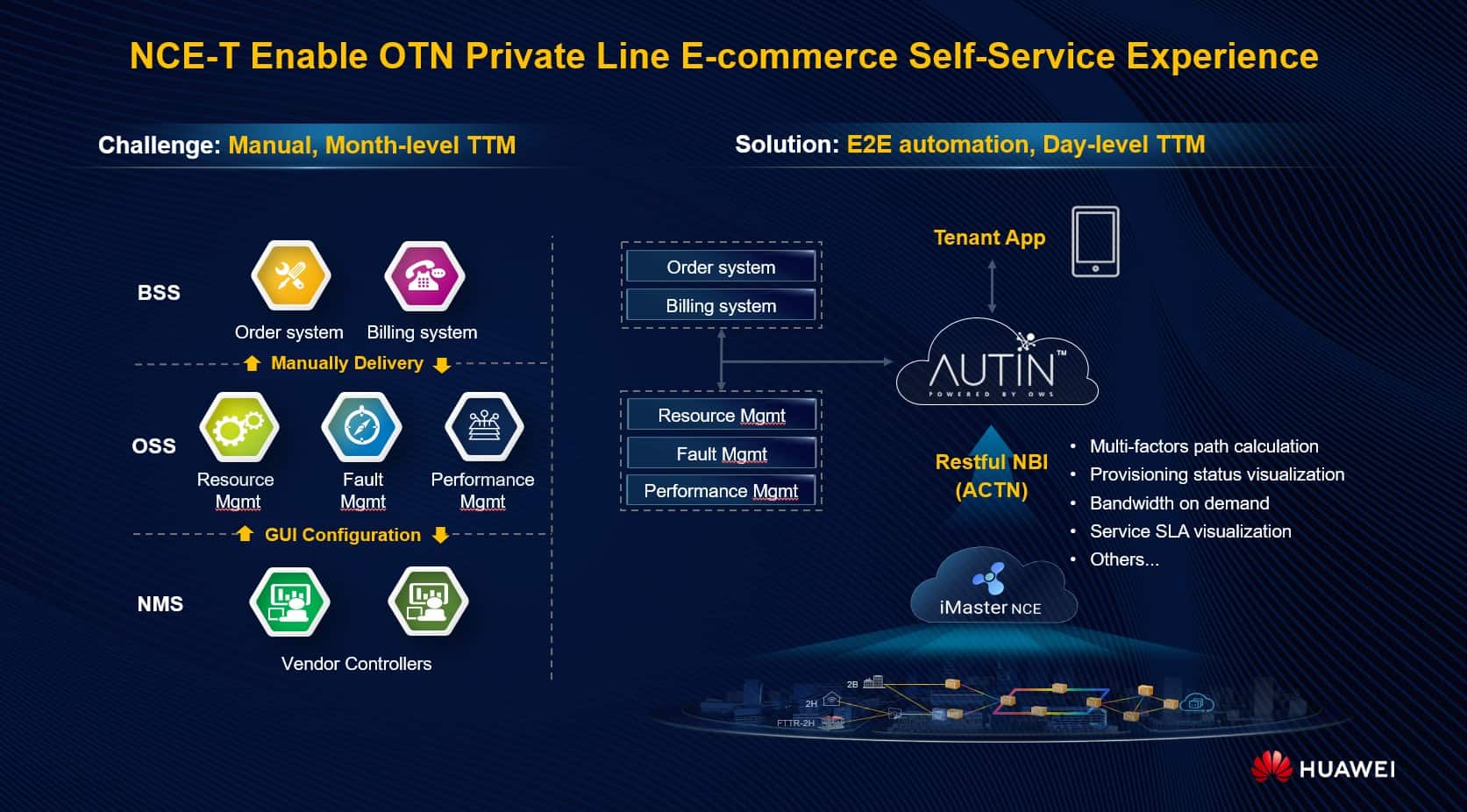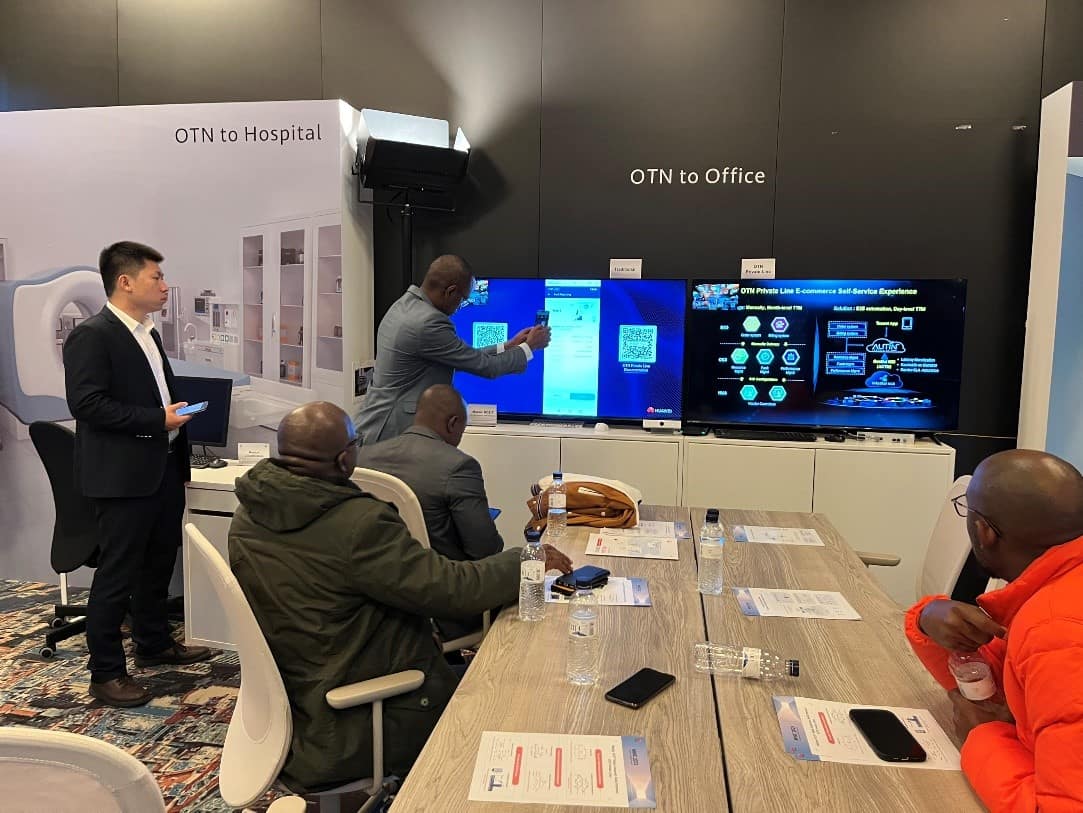Mobile World Congress (MWC) 2023 has just been held in Barcelona, Spain. At its all-optical showcase at the congress, Huawei displayed several innovative solutions for optical transport networks (OTN) to the world. One of the solutions, the OTN private line app, based on the OTN intelligence engine iMaster NCE-T, debuted in the international market. The OTN private line app is a self-service E2E private line service tool dedicated to helping carriers provide an e-commerce-like service experience for enterprise customers, enabling high-quality operations of private line services.
The integration and innovation of technologies such as 5G commercialization, cloud computing, and big data are accelerating digitalization across the world. Private lines, which serve as the basis of digitalization for numerous enterprises, are expanding explosively. According to Omdia, in 2023, the global private line market space will surpass 90 billion dollars, with an annual growth rate reaching 10%. High-value customers have strict and diversified requirements for private lines. For example, government customers are concerned with network availability, whereas financial institutions pay equal attention to network latency and availability, and large-sized enterprises care more about elastic, broad bandwidths. These diversified and experience-oriented requirements present themselves as development opportunities for carriers, but also bring challenges to carriers' private line service operations and capability expansion. Carriers' private line services still suffer from the following bottlenecks:
- Lengthy service expansion: Under conventional operations, it takes a long time for the carrier to satisfy customers' SLA requirements for its network. A customer's SLA requirements must be conveyed between departments within the carrier first. After the planning unit has checked for available network resources, it can then be determined whether suitable routes can be provided for the customer.
- Invisible private line operations: Indicators such as latency, bandwidth, and usage of private line services are usually invisible. Private line customers have no information about the running status of the private lines, and carriers' service SLAs are often faced with default risks.
- Dynamic response incapability: When a customer is in need of bandwidth adjustments, they have to visit a carrier operation outlet and submit their bandwidth adjustment application. Only after network resources have been confirmed across departments, the carrier can manually adjust the bandwidth as required. An application possibly submitted for urgent purposes, is usually accepted at a much later time due to complex processing procedures and emergency response incapabilities on the carrier side.
To facilitate carriers in addressing these challenges, Huawei iMaster NCE, in combination with the AUTIN intelligent platform, integrates carriers' OSS and BSS through the ACTN NBI to visualize OTN private line data, including provisioning progress, customer information, and service status, and enable unified monitoring, O&M management, and operations support for OTN private lines. In addition, Huawei has developed a mobile OTN private line app based on the iMaster NCE-T, which helps carriers put an e-commerce-like experience into practice, realizing a new way of private line operations. Through these new techniques, carriers can ensure high-quality service experience, which monetizes their OTN private lines more rapidly.
 Figure 1: NCE-T enabling e-commerce-like self-service experience of OTN private lines
Figure 1: NCE-T enabling e-commerce-like self-service experience of OTN private lines
- Service expansion: The mobile app provides a pre-provisioning function based on data synchronized from the network management system, resource management system, and order system in real time. Using the pre-provisioning UI, customers can submit their private line requirements based on various parameters, including latency, bandwidth, availability, and usage period, according to which the system will calculate the best route for the private line based on the actual network resources, using the multi-factor, multi-policy intelligent route calculation algorithm built in the NCE. With this function, carriers can efficiently utilize their resources to meet customers' needs, processing diversified requirements with ease.
- Service operations: The performance visualization function via the app allows carriers to check key SLA indicators such as latency, bandwidth, and resource usage of private lines so that they can offer SLA threshold-crossing warnings as well as availability optimization suggestions to their customers. The carriers can also inform customers with high bandwidth usage of the service risks and communicate with the customers over capacity expansion, which may boost the expansion of the private line services.
- Dynamic bandwidth adjustment: For temporary bandwidth adjustment needs, the app also provides an intelligent rate adjustment function. A customer can select an appropriate policy based on their traffic needs on the app and complete the bandwidth adjustment within minutes. In this way, not only the efficiency of responding to customer needs is improved, but customer loyalty can be raised as well.
 Figure 2: A carrier customer scanning the QR code to try out the OTN private line service app
Figure 2: A carrier customer scanning the QR code to try out the OTN private line service app
According to Lu Chi, Vice President of Huawei NCE Optical Network, to improv service effectiveness and quality with an e-commerce-like self-service experience is the latest advancement of the private line service operations, which also constitutes a significant part of helping carriers to build diversified private line competitiveness and to accelerate business monetization by the Huawei OTN private line team. In the future, Huawei will continue to cooperate with carriers and partners to construct SLA-guaranteeing premium private line networks equipped with diversified competitiveness, helping carriers power the high-quality digitalization of thousands of industries with much more advanced and intelligent service experience.



















